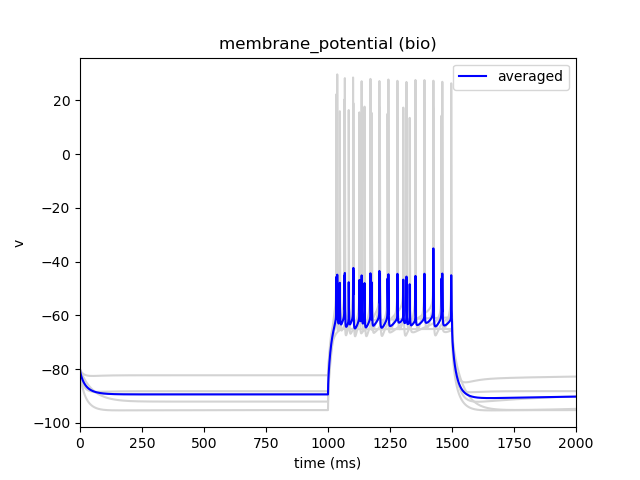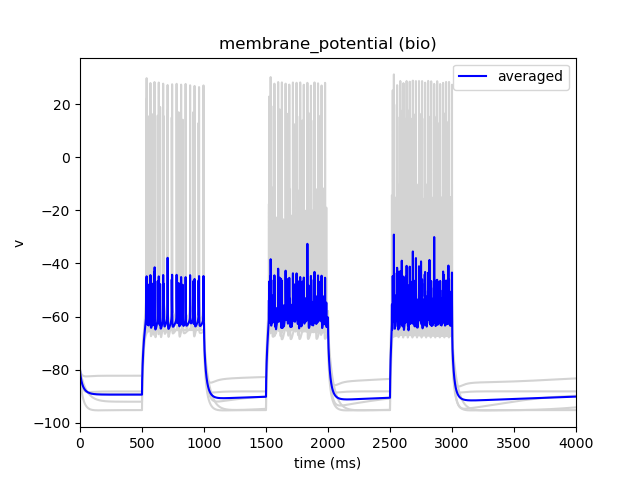Current Clamp [IClamp] Stimulation#
One of the most common way to provide stimulus into a network of cells is to directly inject a current into all or a subset of cells. This can be easily done in bmtk using the “inputs” section of the SONATA simulation config. For example, to provide an single 0.15 pA injection into all cells starting at 1000 ms and ending at 1500 ms; open the simulation json configuration file with your prefered text-editor and add the following subsection to the inputs section:
{
"inputs" {
"current_clamp": {
"module": "IClamp",
"input_type": "current_clamp",
"node_set": "all",
"amp": 0.1500,
"delay": 1000.0,
"duration": 500.0,
"section_name": "soma"
}
}
}
Here “current_clamp” is the name we arbitarily give for this particular input, module and input_type are specify the type of stimulus we are using, and the other parameters are used to define the attributes of our current clamp (see parameter options below).
After saving the file and run the simulation we should see the effect of a direct current injection into the soma of our cell model.

We can also have the option of add multiple independent current clamps in the same simulation, where each one may have a different injection trace, different onset and offset, target different subset of cells or be placed at different locations. For example to apply a series of three different current injections with an increasing amplitude we can just update the json file accordingly
{
"inputs" {
"current_clamp_1": {
"module": "IClamp",
"input_type": "current_clamp",
"node_set": "all",
"amp": 0.1500,
"delay": 500.0,
"duration": 500.0,
"section_name": "soma"
},
"current_clamp_2": {
"module": "IClamp",
"input_type": "current_clamp",
"node_set": "all",
"amp": 0.1750,
"delay": 1500.0,
"duration": 500.0,
"section_name": "soma"
},
"current_clamp_3": {
"module": "IClamp",
"input_type": "current_clamp",
"node_set": "all",
"amp": 0.2000,
"delay": 2500.0,
"duration": 500.0,
"section_name": "soma"
}
}
}

The above is a sequence of different current clamps done in series, but it is possible to have multiple current clamps run in parallel too.
Advanced Stimulus Inputs#
Where there are only a few step currents it is easy enough to use the above method of adding mutliple current clamps in series or in parallel. However for more advanced patterns of stimuli - like randomized noise, ramps, sine waves, etc. - the above method becomes impracticle. Instead of just passing in a single step-block, BMTK provides methods for modifying the input_type to pass in lists or even external files.
List of Amplitudes#
In the above example, instead of using three separate current clamps, we can instead specify just a single one whose amplitudes change over time:
{
"inputs" {
"current_clamp_list": {
"module": "IClamp",
"input_type": "current_clamp",
"node_set": "biophys_cells",
"amp": [0.1500, 0.1750, 2500.0],
"delay": [500.0, 0.1500.0, 2500.0],
"duration": [500.0, 500.0, 500.0]
}
}
}
- Note
Here the “duration” is optional and used to set the injection current back to 0. If not specified BMTK will just update the amp value of the current injection at the next delay
- In many siutations like the one above, replace three separate current clamps with a list will produce the same results, however
it is not guarenteed.
Storing Amplitude Traces in a CSV file#
For even more complex current injection traces, users can create and pass in a csv file of the trace. The csv file should have two columns, one containing the changes in amplitudes and a corresponding one for the respective onsets, labeled amps and timestamps respectivly (although this headers can be changed, see options below) with a space delimiter (which can be changed using options below).
timestamps |
amps |
|---|---|
800.0 |
0.1500 |
810.0 |
0.1600 |
820.0 |
0.1700 |
830.0 |
0.1800 |
… |
… |
Then once the file has been saved update the json configuration. To do so we must make sure the input_type option is set to csv, and instead of options like amp, delay, and duration we just need to point bmtk to the file path of our csv:
{
"inputs" {
"current_clamp_csv": {
"module": "IClamp",
"input_type": "csv",
"node_set": "all",
"file": "custom_current_trace.csv"
}
}
}
Using Allen Cell-Types Database Sweeps#
In the Allen Cell-Types Database there is the option to download the ephys nwb files which include “sweeps” of current injection used to classify various cells and optimize the model parameters.

Using the Download data button will download a nwb file containing various “sweeps” (as can be seen using the select stimulus type and Select sweep buttons). You can recreate these sweeps with BMTK using this downloaded file. As before, we need to update the json simulation configuration file, this time setting input_type to a value allen or nwb, specify the file path of the nwb, and the sweep number to use.
{
"inputs" {
"current_clamp_nwb": {
"module": "IClamp",
"input_type": "allen",
"node_set": "all",
"file": "/626159623_ephys.nwb",
"sweep_id": 29,
}
}
}
IClamp parameters#
- module : string
Should always be set to a value IClamp
- input_type : string
The format of the input, options: current_clamp, csv, file (same as csv), allen, or nwb (same as allen)
- node_set : string, dict, or list
Specify the subset of cells which the injection current will be applied. The default value of all will input the same current clamp to “all” cells in the network. Alternatively, you can filter by properties:
"node_set": { "population": "v1" "location": "VisL4", "model": "PValb" }
Or pass in a list of node-ids
"node_set": [0, 100, 200, 300, 400]
- section_name [optional] : string
For morphologically detailed cells, the section of the cell that the current clamp will be placed. options include soma, axon, dend, apic, other; default value soma
- section_index [optional] : integer
For morphologically detailed cells, the NEURON designated branch of the given section where the current clamp will be placed.
- section_dist [optional] : float [0, 1)
For morphologically detailed cells, the distance along the branch where the current clamp will be placed.
- file : string
When using a csv or nwb input_type, path the file containing current clamp trace (or sweep) and is [required].
Parameters applicable only to current_clamp input_type
- amp : float, list of floats
Amplitudes (pA) of current injection.
- delay : float, list of floats
Current injections onsets (ms) started from simulation time 0.0
- duration : float, list of floats
Current injections durations (ms).
Parameters applicable only to csv input_type
- separator [optional] : string
csv file delimiter used to distinguish columns; defaul “ “ (single space)
- timestamps_column [optional] : string
Header name for column in csv used to specify changes in amplitude values; default timestamps
- amplitudes_column [optional] : string
Header name for column in csv used to specify ampltidue changes at each given timestep; default amps
Parameters applicable only to allen input_type
- sweep_id : integer
The sweep number of the wanted stimulus pattern found in the nwb file
- downsample [optional] : float
When specified, will attempt to downsample the injection current trace. As a good practice it is optimal to set the value to the same as the dt in the simulation configuration. Since for most Cell-Type sweeps the rate of current injection changes is typically much smaller than the simulation dt.
- sweep_window [optional] : [float, float]
Instead of using the full sweep, which is often longer than the simulation time, selection a portion of the sweep time from starting specifying a 0 <= start-time < stop-time < sweep-total-time (in ms).